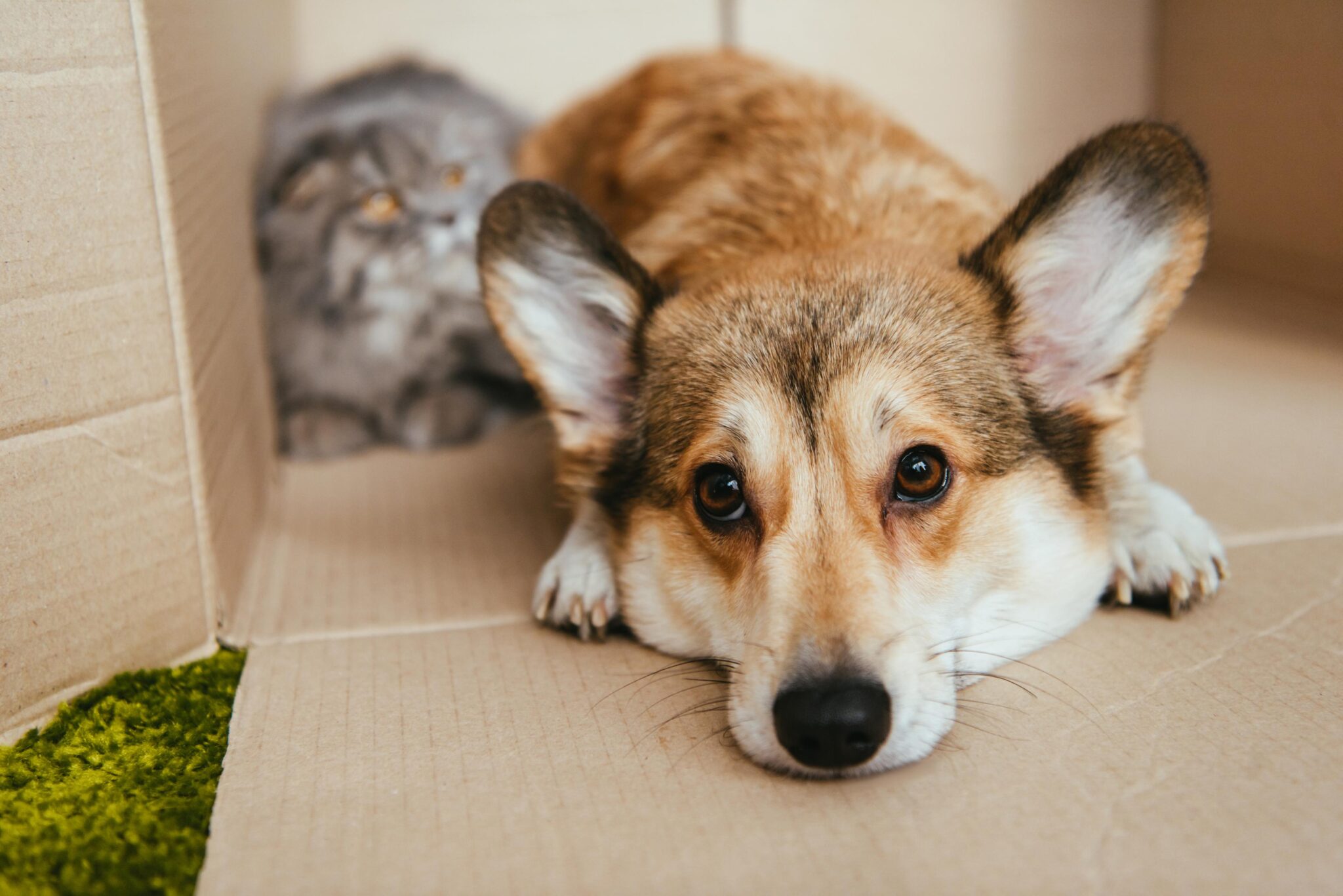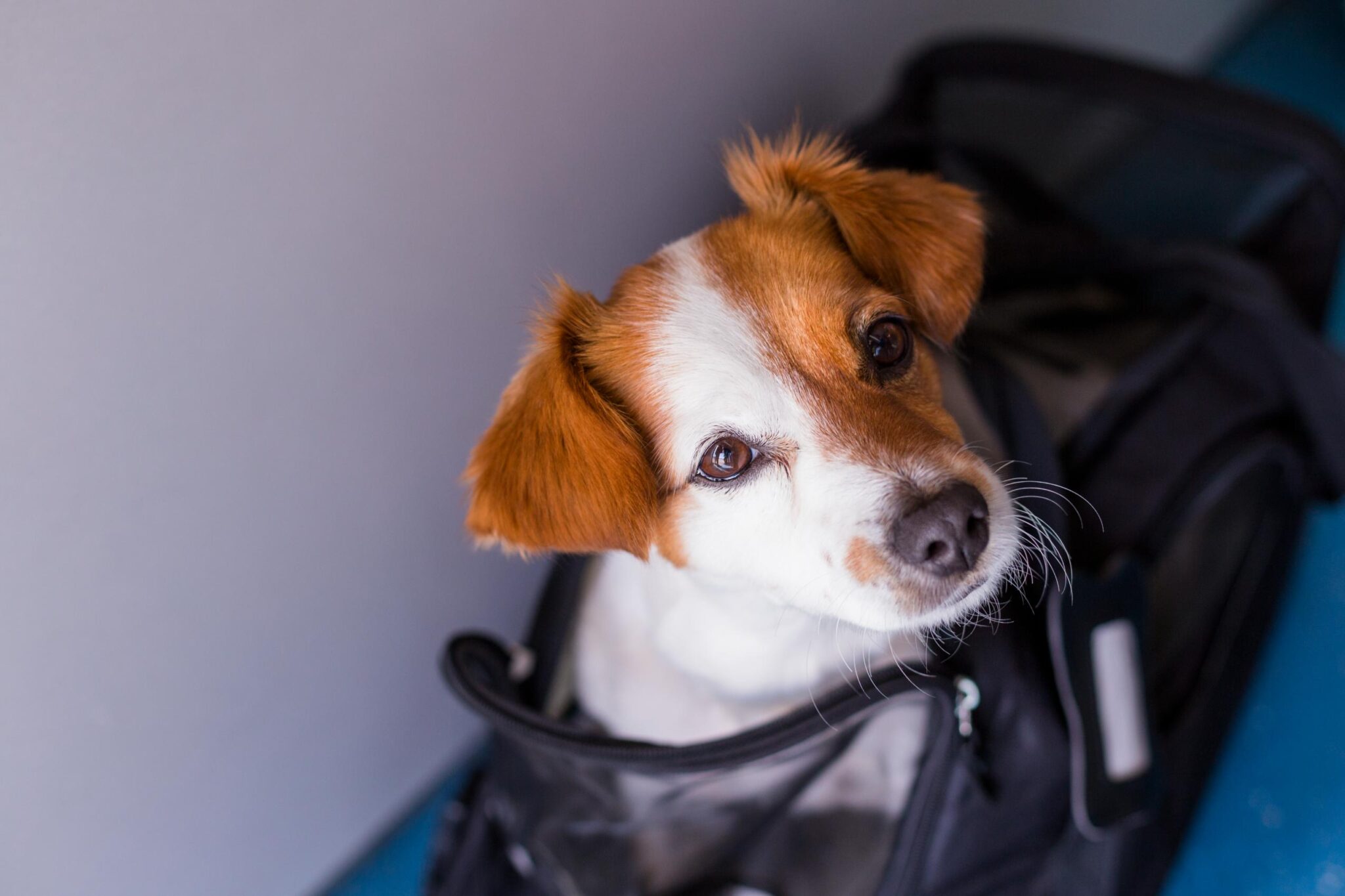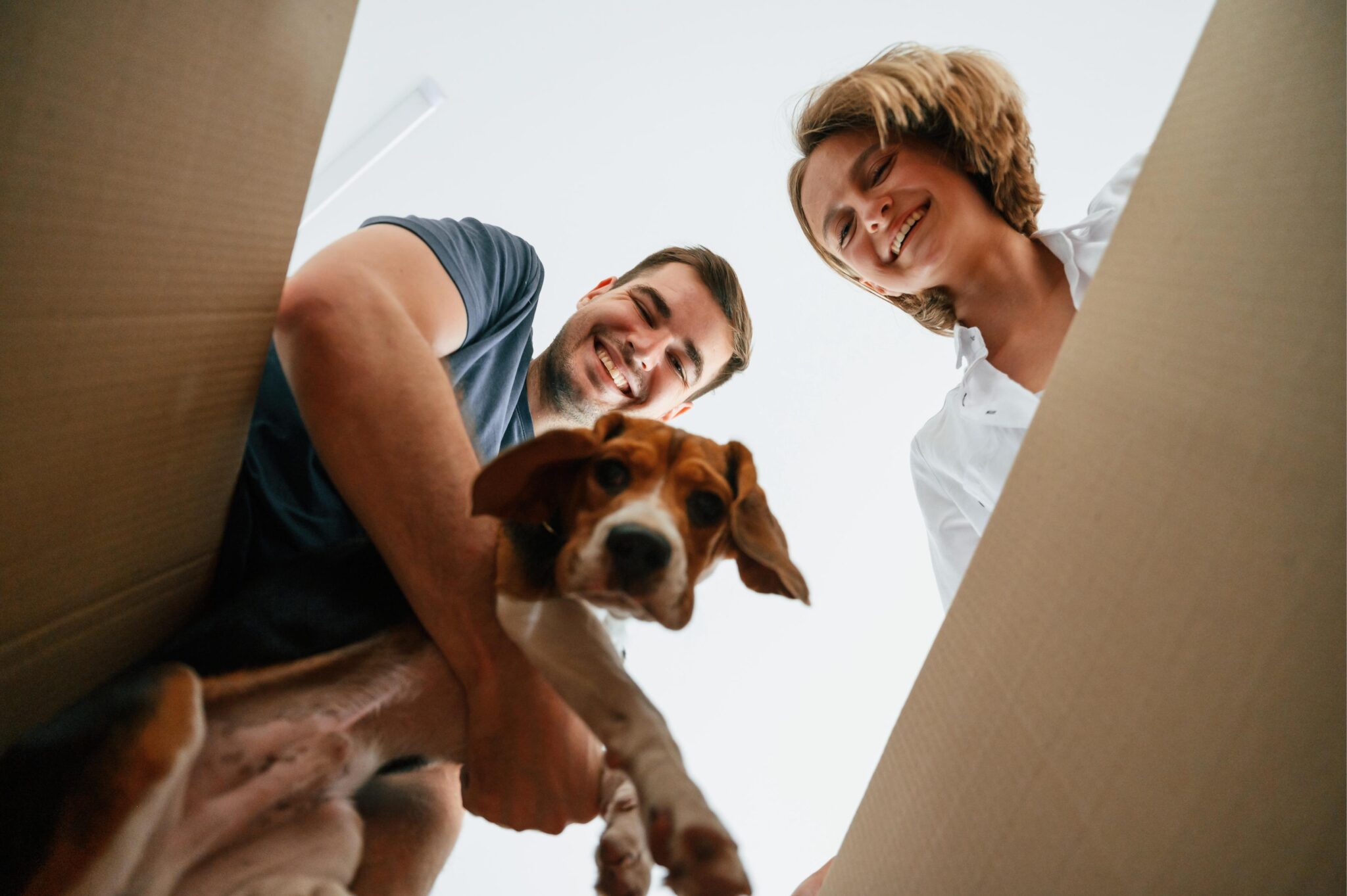Relocating soon? Moving is the start of a new chapter filled with opportunities. But getting from point A to point B can feel overwhelming. There are just so many details and logistics leading up to moving day. And when you’re moving with pets, there’s an added layer of complexity in planning. From finding pet-friendly housing to ensuring your furry friends stay comfortable throughout the process, moving with pets can be a lot to handle. But with a solid plan, you can reduce stress on both you and your pets, making the relocation streamlined and smooth.
As a professional moving company, we’ve helped many families navigate the challenges of pet-friendly moves. If pets are part of your family, here are our top ten tips for making the process smoother, lower stress, and more enjoyable for everyone involved.
1. Plan Ahead for a Pet-Friendly Move

When it comes to streamlined moves, planning ahead is the name of the game! It’s very helpful to create a plan so that you can anticipate needs, know what to expect, and feel more confident about the process. Here are some things to consider while you’re planning for your pet-friendly move:
- Research Pet-Friendly Housing: House hunting? Make sure your new neighborhood welcomes pets. As you’re looking for apartments, houses, or condos, verify that they have pet-friendly policies. Some places have breed restrictions, size limits, or caps on the number of pets allowed. Make sure that your new home is a good fit for your furry family members.
- Check for Nearby Amenities: Moving with pets? Find out about pet-friendly amenities in your new community. Get info about parks, walking trails, veterinary clinics, and pet stores that might meet your needs. When you have these services in your area, it can make it easier to maintain your pet’s routine and meet their needs. If there aren’t amenities like these in your community, it’s good to know so that you can find services nearby.
- Safety First: Is your new home pet-ready? Make sure the yard is safe and has secure fencing. Inside, make sure to pet-proof your home. A secure environment can help your pet feel safe — and also prevent accidental escapes or injuries.
- Community Considerations: Look into the pet culture of the new community. Are there active pet owner groups or regular pet-friendly events? A supportive pet community can help you adjust more quickly to the new environment.
2. Visit the Veterinarian Before Moving

Before the move, plan a check-up with your pet’s veterinarian. Here are some things to talk over:
- Health Check-Up: Schedule a comprehensive health check-up for your pets to ensure they are fit for the move. Address any existing health issues and update vaccinations to comply with local regulations in your new area.
- Get Necessary Documents: When you’re moving with pets (especially for long-distance or international moves), make sure to gather needed health certificates and records. Some locations require health inspections or quarantines for pets, and having documentation handy helps make the process smoother.
- Discuss Travel Plans: Is your pet prone to motion sickness or anxiety? Talk to your veterinarian about any concerns related to travel. Your vet may recommend medications or natural remedies to help your pet stay calm during the move.
- Preventative Care: Before the move, make sure that all flea, tick, and heartworm preventatives are up-to-date. Moving to a new area with different climates or wildlife can expose your pets to new risks, so don’t forget to take preventative measures.
3. Update Your Pet’s Identification and Microchip
Are your pet’s records up-to-date? Keep your pet safe and have peace of mind with these steps:
- Update ID Tags: Make sure your pet’s ID tags reflect your new address and contact information. Clear identification can help reunite you with your pet if they become lost during the move.
- Microchip Registration: Verify that your pet’s microchip information is current. If necessary, update the microchip details with your new address and phone number to ensure it works effectively in your new location.
- Temporary Identification: Consider adding a temporary tag with your pet’s new destination and contact information. Moving with pets can be stressful, and this provides an extra layer of security during the moving chaos.
- Digital Records: Keep digital copies of your pet’s identification and medical records accessible. Storing these on your smartphone or a cloud service ensures you have them handy when you need them.
4. Keep Pets Comfortable on Moving Day
Moving can be stressful for pets. Here are some ways to minimize pet anxiety on moving day:
- Create a Safe Space: Designate a quiet, secure area in your current home where your pets can stay away from the moving chaos. Use gates or closed doors to keep them calm and prevent them from escaping.
- Familiar Items: Bring your pet’s favorite bedding, toys, and blankets to their safe space. Familiar scents and objects can provide comfort and reduce anxiety during the move.
- Maintain Routine: Keep feeding and walking schedules as consistent as possible on moving day. Familiar routines help pets feel secure and reduce stress.
- Minimize Noise: Loud noises can be unsettling to pets. Help keep pets relaxed by turning off loud appliances and using white noise machines.
5. Arrange Safe Transportation for Your Pet
During travel, make sure your pet is safe and comfortable with these tips:
- Choose the Right Carrier: Invest in a high-quality pet carrier that is well-ventilated and appropriately sized for your pet. A secure carrier can help make moving with pets less stressful for your furry friend.
- “Harness” the Harness: For pets that prefer not to be in carriers, use travel harnesses or seat belts designed for animals. These help prevent your pet from moving around too much in the vehicle.
- Plan for Breaks: If you’re driving a long distance, make sure to schedule regular breaks to use the bathroom, eat, and get a drink of water. Plus, stretching their legs helps pets from getting too restless so they can travel comfortably.
- Please Never Leave Pets Unattended: If you’re driving, avoid leaving pets alone in the vehicle. This can help prevent serious health risks like heat stroke or hypothermia.
6. Pack a Pet Essentials Bag

During any move, it’s important to pack essentials for the journey to your new home. Along with your bag, here are some things to have handy for your pet:
- Essential Supplies: Pack a separate bag for your pet’s essentials, including food, water, bowls, medications, and favorite comfort items. Having these items easily accessible reduces stress during the move.
- Cleaning Supplies: Include cleaning supplies like paper towels, disinfectant wipes, and plastic bags in case of any accidents during the journey. Being prepared helps you handle unexpected messes efficiently.
- First Aid Kit: Put together a basic “moving with pets first aid kit” with items like bandages, antiseptic, and any prescribed medications. This ensures that you’re ready to protect your pet’s well-being if any health issues arise.
- Documentation: Keep your pet’s medical records, identification, and any necessary permits in the essentials bag. Having these documents on hand can be crucial in case of emergencies.
7. Prepare for Air Travel if Necessary
Flying to your destination? Follow these tips for more streamlined, pet-friendly travel:
- Research Airline Policies: Different airlines have varying pet policies: carrier sizes, fees, and in-cabin versus cargo transportation. Make sure you choose an airline that can accommodate your pet’s needs.
- Book Direct Flights: Whenever possible, book direct flights. Making fewer stops can reduce the chances of delays and lessen your pet’s overall travel stress.
- Acclimate Your Pet: When a pet isn’t used to their carrier, it can be jarring to feel cooped up for hours. Help your pet get accustomed to their carrier before the move by gradually encouraging them to spend time inside. Being familiar with the carrier can help reduce anxiety during the flight.
- Bring Comfort Items: Place a familiar blanket or toy inside the carrier to provide comfort and reassurance during the flight. Comfort items can help soothe your pet and make the travel experience less stressful.
8. Help Pets Adjust to the New Home

You’ve made it to your new home! Congrats! Before settling in, make sure the new environment is ready for your pet to feel at home.
- Moving With Pets: Setting up a Safe Space: Upon arrival, designate a specific area in your new home where your pet can stay initially. Fill it with their familiar items to create a sense of security.
- Give Them Time: Slowly introduce your pet to the new environment. Allow them to explore one room at a time, preventing them from feeling overwhelmed by the vastness of the new space.
- Maintain Routines: Stick to your pet’s regular feeding, walking, and playtime schedules to provide a sense of normalcy. Consistent routines help pets adapt more quickly to their new surroundings.
- The “Good Boy” Treatment: Use positive reinforcement like treats and praise to encourage your pet to explore and feel comfortable in the new home. Rewarding your pet for calm behavior can help them adjust more quickly.
9. Ease Pets’ Anxiety and Manage Behavioral Changes
Has Whiskers been acting strange? Animals don’t always know how to respond to the changes associated with a move. Here are some ways to help them relax and adjust:
- Monitor Behavior: Before, during, and after moving with pets, watch their behavior for signs of stress. Things like hiding, excessive barking, or changes in appetite might indicate anxiety. Noticing these signs early can help you address issues promptly.
- Calming Aids: Ask your vet about calming products like pheromone diffusers, anxiety wraps, or natural supplements to help soothe your pet. These aids can reduce anxiety and promote a sense of calm.
- Provide Attention: Spend extra time with your pet to offer reassurance and comfort. Extra playtime, cuddles, and gentle grooming can help ease their stress and strengthen your bond during the process.
- Talk With Your Veterinarian: If your pet shows severe or persistent anxiety, consult your veterinarian. They can recommend appropriate treatments or therapies to help manage your pet’s stress.
10. Find a New Veterinarian and Pet Service

The last tip on our list is to find out about veterinary and other services in your new community. Here are some services to check out:
- Locate a Veterinarian: Research and choose a reputable veterinarian in your new area before moving. Having a trusted vet lined up ensures that your pet’s health needs are met promptly after the move.
- Emergency Care Facilities: Find out about nearby emergency pet care facilities in case of unexpected health issues. Knowing where to turn in an emergency provides peace of mind while you’re moving with pets.
- Explore Local Pet Services: Look into local pet stores, groomers, and training centers to meet your pet’s ongoing needs. Making these connections early can help your pet quickly settle into the new community.
A Streamlined and Low-Stress Move for You AND Your Pets
Moving with pets requires some extra planning, but it doesn’t have to be stressful. WIth a plan, the right strategies, and some patience, you AND your pet can have a great moving experience. We hope that these tips have been helpful as you prepare for your upcoming move. Here at Scobey, we’re here to help you start your next chapter off on the right foot (or paw)! We’d love to help your whole family have the best move possible.


